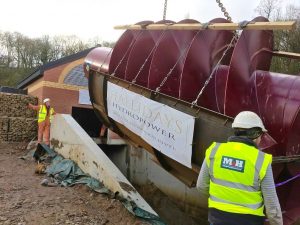Hydropower is a form of renewable energy that is generated by running water over a hydro turbine to convert mechanical energy into electricity. Most commercial turbines are small and micro in size. Small hydropower turbine design produces less than 1MW of power while the microturbines produce 100 kW or less. The typical small hydroelectric turbine design powers around 1000 homes while microsystems can power 100 homes or even one home.
Hydropower Turbine Design
There are several types of hydro turbine design on the market, each with specific head and flow capacity. Head is the difference in height between the highest water level and the location of the turbine measured in metres. Flow is the amount of water running in the system at any time indicated in cubic metres per second (m3/s). It is important that you get the most appropriate turbine for your site to maximise power generation.
The list below provides a comprehensive review of the small hydro turbine design available in the UK.
Archimedean Screw
- Head: 1.5-5 metres
- Flow: 1 -20 m3/s
- Appropriate for sites with a low head and medium to high flows.
- Higher flows require multiple turbines.
Kaplan turbine
- Head 1.5-20 metres
- Flow: 3 -30 m3/s
- Appropriate for sites with low to medium heads and medium to high flows.
- Higher flows may require several turbines.
Crossflow turbine
- Head: 1.5-20m
- Flow:0.1 -5 m3/s
- Suited to sites with low to medium heads and flows.
Francis turbines
- Head: 1.5-20 metres
- Flow: 0.5-4 m3/s
- Suited to sites with low to medium heads and medium flows.
Turgo/Pelton turbine
- Head: higher than 25 metres
- Flow: 0.01 -0.5 m3/s
- Suited to sites with high heads and low flows such as highland streams.
Waterwheels
- Head: 1-5 metres
- Flow: 0.3-1.5 m3/s
- Requires low heads and medium flows.

A hydro turbine is engineered to utilise the mechanical action of water to produce electrical energy. As opposed to fossil fuels, hydroelectric power is completely sustainable and associated with only a minimal impact upon the environment. It is still important to appreciate the basics of hydroelectric turbine design in order to appreciate just how far this technology has come in recent years. Let us therefore take a quick look at some of the primary principles and features of a typical hydro turbine design.
The Basic Purpose of a Hydro Turbine
Hydroelectric turbines are designed to transform the energy associated with moving water into mechanical energy. This is accomplished through the use of a series of plastic or metal blades which are connected to a central shaft. These vanes are placed at specific angles. As water passes through, it causes the entire apparatus to rotate (similar to a jet engine). This kinetic rotation is subsequently sent to a nearby generator. The generator thereafter converts mechanical energy to electrical power. The power can then be passed on to the public via typical transmission lines. The size and number of turbines equates to the power output of the plant itself.
Design Variations
While the basic principle behind this type of energy generation is straightforward, it is important to mention that the actual hydroelectric turbine design can vary. For example, reaction turbines employ a change in water pressure to generate electrical power. Impulse turbines instead utilise a series of high-pressure nozzles. These nozzles will direct pressurised water towards spoon-shaped appendages located on the turbine. The central shaft then begins to rotate; providing the mechanical force required for a generator to produce electricity. Several additional variants can be found within these two classes such as:
- Pelton water turbines
- Turgo water turbines
- Kaplan designs
- Cross-flow configurations
The main takeaway point is that all hydro turbine designs are engineered to provide a reliable source of electricity by using the power of moving water.
Why work with Hallidays Hydropower?
Hallidays has vast experience in installing hydropower turbines for customers around the UK. When you contract us, we conduct a feasibility study of the site to determine the power potential and other requirements. This is followed by planning, obtaining consents and licenses, designing the power plant, and determining the hydro turbine design that is most suited to the site. We also offer maintenance packages to our customers to ensure the plant is always in good condition.
Please feel free to speak with one of our representatives at Hallidays Hydropower International if you are curious to know which solution is the most relevant for your needs.